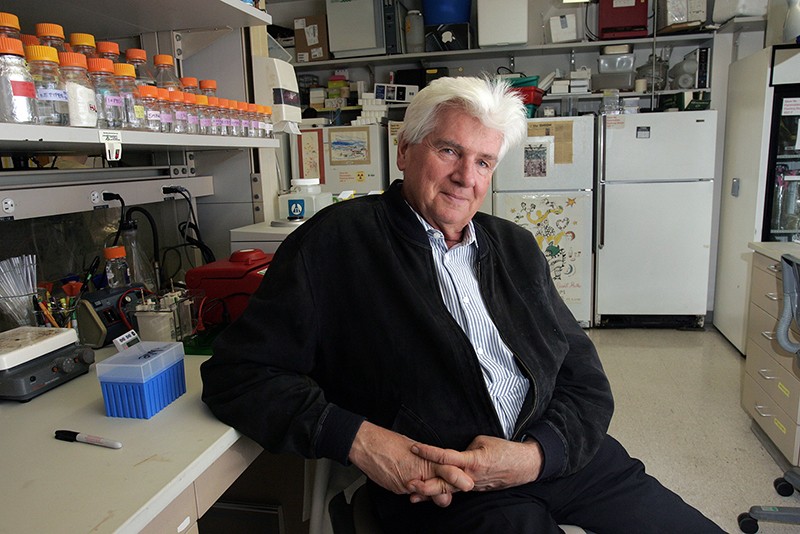For much of the twentieth century, biologists puzzled over how the proteins that build, run and leave cells get where they need to be. Over five decades, biologist Günter Blobel hammered out the answer: the ‘signal hypothesis’, a targeting system resembling a set of postal codes. It earned him the Nobel Prize in Physiology or Medicine in 1999.
The steps to and beyond this discovery helped to explain normal cell organization, as well as many diseases in which the transport of proteins is defective. The signal hypothesis also laid the foundations of modern biotechnology. Proteins such as human insulin and human growth hormone could be tagged for mass production in bacteria, secreted and easily collected.
Blobel’s pathway to the prize began at the Rockefeller University in New York City, where he spent 50 years. As a postdoc in George Palade’s laboratory during the late 1960s, he studied the secretory pathway taken by proteins set to be extruded from the cell. He and cell biologist David Sabatini found that newly minted proteins could not be digested as they emerged from the ribosomes that synthesize them. The pair concluded that the proteins entered the secretory pathway as they were made.
Blobel and Sabatini proposed that these proteins have a distinctive region — their postal code — that is recognized by special chaperones that guide the part-synthesized protein and its ribosome to a cellular organelle called the endoplasmic reticulum. There, protein synthesis is continued as the protein crosses into the organelle and enters the secretory pathway.
Many advances in our understanding of metabolism come from breaking cells into their components, and then reassembling the parts to work out which component does what. Blobel used this approach to test his hypothesis. He mixed ribosomes, the messenger RNA that encodes proteins, cytosol and membranes in vitro. His experiments failed repeatedly.
But he never gave up. He continued mixing components from different organisms, convinced that, like the alchemists, if he had just the right ratios or sources of ingredients, he could create something new. Finally, in 1975, after four years in the cold room, he got a clear result: his nascent protein seemed to target and enter the secretory pathway.
As with most research, there was not one ‘aha’ moment. Blobel fretted about ugly facts that could destroy his beautiful hypothesis. Perhaps the protein did not enter the secretory pathway, it was just stuck on the outside? Maybe the tests he was using to determine whether the protein entered the pathway were faulty? Two papers, published with cell biologist Bernhard Dobberstein in the Journal of Cell Biology in 1975, set out crucial experimental evidence amid a flurry of controls.
The assays Blobel had developed using mainly mammalian components were quickly used to identify the signals that dispatch proteins to other cell compartments — such as mitochondria, and to chloroplasts in plant cells — and to identify similar systems in yeast and bacteria. The assays were applied to proteins to be secreted and those that would end up spanning membranes. The system was highly conserved: a mixture of human mRNA encoding a secretory protein, ribosomes from rabbit blood and membranes from yeast could synthesize the human protein. The impact of Blobel’s work cannot be overstated.
Blobel’s career was filled with audacious speculations. “I always imagined how things would be,” he once said. For him, the thrill was the experimental chase. Yet he cautioned trainees to be ready to abandon their fantasies, “when data come which aren’t compatible”. His speculations concerned the regulation of gene expression, the channels through which proteins crossed membranes and the pores that are the gateway into the cell’s nucleus.
When necessary for his work, he learnt yeast genetics, modern structural biology and electrophysiology. Inured to the ridicule of his speculations, he once said, “There is an internal revolt in me against conforming. After the war, my family lived in East Germany and that taught me that truth is the most holy and important thing in life.”
Blobel grew up in the Silesian village of Waltersdorf, where his father was a veterinary surgeon. As the Second World War was drawing to its end, when Blobel was 9, his family fled west, passing through Dresden. It was his first exposure to a big city. As an adult, he often recalled being entranced by the many spires and the magnificent cupola of the Frauenkirche. A few days later, he saw fire-bombing bring the church and city to ruin.
Blobel studied medicine in Germany, but grew frustrated that it treated symptoms rather than the causes of disease. He emigrated to the United States to do a PhD with Van R. Potter at the University of Wisconsin–Madison. There he succeeded in isolating the nucleus, which he investigated throughout his career with infectious enthusiasm. In his last years in the lab, he proposed large changes in the structures of the pores that regulate the passage of material in and out of the nucleus. He dubbed these changes ‘the ring cycle’, in tribute to the Wagnerian operas he enjoyed on rare outings from the Rockefeller campus.
Blobel was passionate about architecture — of cities as well as of cells. He donated his US$960,000 Nobel winnings to two extraordinary projects: the rebuilding of the bombed Frauenkirche, and of the Dresden synagogue, destroyed on Kristallnacht.
Debonair and jovial, Blobel appreciated repartee and a well-told tale. His wife, Laura Maioglio, was a frequent participant in Blobel lab functions and scientific affairs at Rockefeller. And Blobel held court in her famed restaurant on Broadway, Barbetta, debating literature, design, music and, of course, science. There, with his shock of white hair and emphatic gestures, he did recall the alchemists of old. Fittingly, his wizardry transformed our understanding of the cell.
